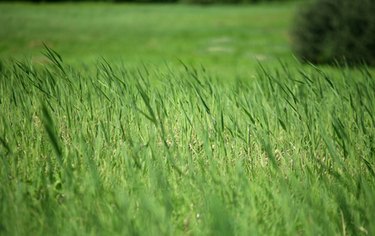Things You'll Need
Large pot
Garden scissors
Cheesecloth
Water
White vinegar
Natural fiber shirt
Iron

Before chemical dyes were invented, people boiled plants to extract colorful dyes. They used everything from berries to plant roots to simple blades of grass. Many people still use plant dyes to tie-dye their clothing either as an inexpensive project or as a part of the green movement. Dyeing with plants is simple and results in lovely, gentle colors. However, if you are just beginning to dye with plants or are unwilling to use your valuable fruits, vegetables and herbs to simply dye shirts, try grass. Many homes have lawns with abundant grass. The result will be green-yellow to dark green shirts. You can gather plenty of grass right after mowing the lawn.
Step 1
Gather up some freshly mowed grass or snip it yourself, making sure to get lengths about 3 inches or longer. Make sure the grass is fresh; dried grass no longer has chlorophyll inside it to give your shirts color. Gather about 5 cups of clippings to make one gallon of dye.
Video of the Day
Step 2
Snip the grass into 1 inch lengths and place them in the middle of a square of cheesecloth. Tie the cheesecloth into a bundle. Pour a mixture of equal parts white vinegar and water into a gallon-sized pot and bring it to a boil. Add the cheesecloth bundle and simmer it for about 20 minutes or until the grass blades look pale and bleached.
Step 3
Wash and dry your natural-fiber (linen, wool, silk, hemp, muslin) shirt to remove sizing and dirt. Soak it thoroughly in cool water and add it to the dye bath. Simmer the shirt for 30 minutes to one hour depending on how light or dark you want your color.
Step 4
Remove your shirt from the dye and rinse it in cool water until the water running from it runs clear. Allow the shirt to air dry and iron it on low heat to set the color. If you want the shirt to be darker, repeat the above process until satisfied.
Video of the Day